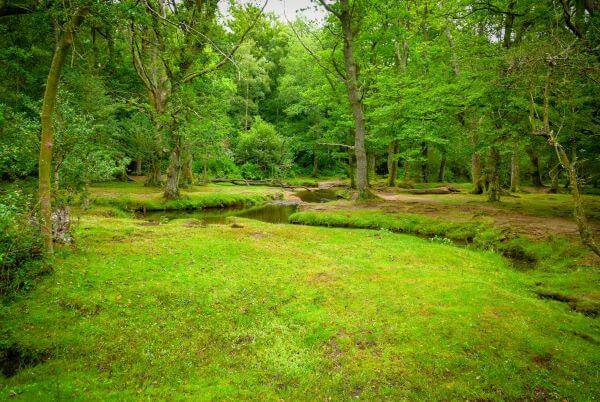The England Trees Action Plan one year on: an update for landowners

In May 2021, The Department for Environment, Food & Rural Affairs unveiled the England Trees Action Plan, a blueprint which set out the Government’s long-term vision for trees in England up to 2050 and beyond.[1] Core to the plan is a goal to increase England’s woodland cover from 10% to 12% by 2050, and to support this the HM Treasury in 2020 committed to spending more than £500 million to fund trees and woodland between 2020/21 and 2024/25.[2] In October 2021, a further £124million was announced to cover both trees and peat.[3]
The plan sets out over 80 policy actions to deliver on its aims, which include working toward net-zero carbon, addressing biodiversity loss and creating green jobs.
When the plan was launched it was welcomed by the Forestry Commission, but what progress has been made since then, and what does it all mean for farmers and landowners?
What is in the Plan?
The plan stresses the importance of planting the right trees in the right places to encourage biodiversity. It aims to at least treble tree planting rates in England by the end of this Parliament to 7,500 hectares per year, to meet the UK’s overall target of planting 30,000 hectares per year. This means the Government plans to plant around 90-120 million trees each year by 2025.
It seeks to expand the size of England’s forests by working with both public and private landowners to create new woodlands. The plan encourages farmers and landowners to plant native broadleaf trees on their land, which will be incentivised through the England Woodland Creation Offer (ECWO).
The England Woodland Creation Offer
The ECWO is major woodland creation grant that was launched in the 2020 budget and will remain open until 2024. Made possible through the Nature for Climate Fund, it was launched with £640million in funding and is set to receive a further £110million. It aims to create 10,000 hectares of new woodland.[4]
There are four types of payment available under the scheme:
Payments to cover 100% of the standard costs of establishing new woodland;Ten years of annual Maintenance Payments to help establish the young trees;A contribution towards the actual cost of installing necessary infrastructure to enable either current or future woodland management, or to provide access for recreational purposes;Payments called Additional Contributions if the woodland will deliver public benefits.
The Additional Contributions are optional one-off payments. It’s possible to apply for multiple payments for the same land. Additional Contributions include:
Nature Recovery – up to £2,800 per hectare for woodlands that restore nature and speciesFlood Risk – £500 per hectare for woodlands that help reduce the risk of floodingWater Quality – £400 per hectare for woodlands that will improve water qualityRiparian Buffers – £1,600 per hectare for woodlands along riverbanks that improve water habitatClose to settlements – up to £500 per hectare for creating woodlands close to where people liveRecreational Access – up to £2,200 per hectare for providing access to woodlands for the public to enjoy[5]
Under the scheme, landowners can also register with the Woodland Carbon Code (WCC) and apply to the Woodland Carbon Guarantee (WCaG) to gain extra income from selling carbon.
Defra recommends that farmers and landowners considering making an application to the EWCO reach out to their local Woodland Creative Officer (WCO) for guidance and assistance.[6]
What does it mean for farmers and landowners?
The government wants to see more trees on farmland and estates, with strategic planting where trees are likely to have the greatest impacts on water, biodiversity, climate change and communities.[7]
This will be a balancing act for farmers who want to ensure the profitability of their land, however, with a decade of support promised, there is a clear financial incentive. There are other benefits, too. The plan will protect water and improve soil management as well as ensuring that trees and woodland contribute to more business’s bottom lines.[8] From nature and species recovery to climate resilience, the benefits of planting more trees will be long-lasting and felt across the country.
What progress has been made – and what happens after 2025?
In January 2022, Defra confirmed it had planted 31% of the trees it said it would plant in 2021-2022 – that’s 809 hectares.[9] The 2020/21 planting season proved difficult for Defra, with challenging working conditions and limited opportunities for site visits due to the pandemic as well as staffing shortages to contend with.[10] Despite this, seven schemes were launched between April and June 2021. At the time of writing, Defra has not made its monitoring and evaluation public, though this was expected in April 2022.[11]
Because the right trees (native broadleaf species) must be planted in the right places to ensure biodiversity and biosecurity, there have been increased efforts to ensure that only beneficial species are sourced. From June 2022, applicants to government tree planting grants must source their saplings from approved suppliers only.[12] Defra also promotes the Forestry Commission’s “climate matching tool”, which helps landowners to understand which trees are best suited to their land – taking into account that the climate will change over time.[13]
After 2024/25, the UK will still be working towards net zero carbon emissions and Defra expects tree planting rates to continue to rise in support of this. While the England Trees Action Plan will expire, tree planting will continue to be delivered through the Environmental Land Management scheme (ELM), part of Defra’s wider Future Farming and Countryside Program. When Defra launches the ELM in 2025, it will offer payments to farmers and landowners for taking actions on their land that benefit the environment, including planting trees.[14]
[1] https://www.gov.uk/government/publications/england-trees-action-plan-2021-to-2024
[2]https://assets.publishing.service.gov.uk/government/uploads/system/uploads/attachment_data/file/987432/england-trees-action-plan.pdf
[3] chrome-extension://efaidnbmnnnibpcajpcglclefindmkaj/https://www.nao.org.uk/wp-content/uploads/2022/03/Tree-planting-in-England-Summary.pdf
[4] https://www.edie.net/defra-unveils-new-grant-scheme-for-woodland-creation-as-post-brexit-green-watchdog-finally-launches/
[5] https://www.gov.uk/guidance/england-woodland-creation-offer#how-it-works
[6] https://www.gov.uk/guidance/england-woodland-creation-offer
[7]https://assets.publishing.service.gov.uk/government/uploads/system/uploads/attachment_data/file/987432/england-trees-action-plan.pdf
[8]https://assets.publishing.service.gov.uk/government/uploads/system/uploads/attachment_data/file/987432/england-trees-action-plan.pdf
[9] chrome-extension://efaidnbmnnnibpcajpcglclefindmkaj/https://www.nao.org.uk/wp-content/uploads/2022/03/Tree-planting-in-England-Summary.pdf
[10] chrome-extension://efaidnbmnnnibpcajpcglclefindmkaj/https://www.nao.org.uk/wp-content/uploads/2022/03/Tree-planting-in-England-Summary.pdf
[11] chrome-extension://efaidnbmnnnibpcajpcglclefindmkaj/https://www.nao.org.uk/wp-content/uploads/2022/03/Tree-planting-in-England-Summary.pdf
[12] https://www.gov.uk/government/news/new-pilot-requirement-for-tree-suppliers-announced-to-strengthen-uk-biosecurity
[13] https://www.gov.uk/guidance/selecting-tree-seeds-for-current-and-future-climates-in-order-to-maintain-productivity
[14] chrome-extension://efaidnbmnnnibpcajpcglclefindmkaj/https://www.nao.org.uk/wp-content/uploads/2022/03/Tree-planting-in-England-Summary.pdf







